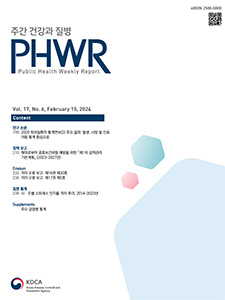Current Issue
Vol.17 No.6, February 15, 2024
-
Original Articles 2024-02-15
 0
0
 311
311
 149
149
Key Findings from 2020 Annual Report on Rare Disease (2) Patients in Korea: Incidence, Mortality and Medical Service Utilization
Kyoung-Hwa Choi, Woo-Mi Cho, Ji-hwan Sung, JiWon M. Lee
Public Health Weekly Report 2024; 17(6): 199-217 https://doi.org/10.56786/PHWR.2024.17.6.1 Abstract
AbstractThe Korea Disease Control and Prevention Agency approved the “Rare Diseases Statistics in Korea” as national statistics in 2019. It published the “2019 Annual Report on Rare Disease Patients in Korea” for the first time in December 2020. It systematically collects, refines, and analyzes data related to the occurrence and treatment of rare diseases every year and provides results. Accordingly, in the “2020 Annual Report on Rare Disease Patients in Korea (2)”, detailed statistics of the year which were different from the “2020 Annual Report on Rare Disease Patients in Korea” announced in 2021 were included in the 2020 report. Therefore, the incidence, mortality, and medical service utilization of patients with rare diseases were included in the same annual report. In this report, we present the main results to promote the use of the “2020 Annual Report on Rare Disease Patients in Korea (2),” published in 2022. A total of 52,310 rare disease cases occurred among 694 diseases between January 1 and December 31, 2020, including 25,353 male (48.5%) and 26,957 female (51.5%). The death statistics referred to those who died in the same year among the cases in 2020. A total of 1,662 of 52,310 cases in 2020 died. The medical use of patients with rare diseases was calculated based on current benefit status and treatment details for the last 3 months after the registration of rare diseases in 2020. In the three months, 48,115 people were treated, and the average total cost per person was 3.1 million won. Among the treatment details, the injection, hospitalization, examination, and consultation fees were the largest in the order of payment. Since the “Annual Report on Rare Disease Patients” is written only for new patients registered for differential copayments, there are limitations, such as no information on unregistered patients. We will continue to strive to improve the “Annual Report on Rare Disease Patients” to provide more useful and accurate information.
-
Policy Notes 2024-02-15
 0
0
 458
458
 109
109
The First Master Plan for Quarantine Management to Prevent Foreign Public Health Threats (2023–2027)
Jinuk Park, Jongha Park, Jaewoo Kwon
Public Health Weekly Report 2024; 17(6): 218-232 https://doi.org/10.56786/PHWR.2024.17.6.2 Abstract
AbstractQuarantine is an important measure of protecting public health and minimizing social and economic burden by preventing and managing the diffusion or inflow of public health threats from other countries. The Master Plan for Quarantine Management establishes an objective for the quarantine policy and suggests strategies for a 5-year period by analyzing the past quarantine management protocols. This article outlines the direction of the Republic of Korea’s quarantine management for health security, emphasizing its increased importance with the introduction of a master plan for quarantine management.
-
Erratum 2024-02-15
 0
0
 113
113
 125
125
Erratum : Volume 16. No 30.
Public Health Weekly Report 2024; 17(6): 233-235 https://doi.org/10.56786/PHWR.2024.17.6.3 -
Erratum 2024-02-15
 0
0
 165
165
 69
69
Erratum : Volume 17. No 5.
Public Health Weekly Report 2024; 17(6): 236-237 https://doi.org/10.56786/PHWR.2024.17.6.4 -
QuickStats 2024-02-15
 0
0
 158
158
 60
60
Trends in the Prevalence Gap of Perceived Stress between Cities or Provinces, during 2014–2023
Public Health Weekly Report 2024; 17(6): 238-239 https://doi.org/10.56786/PHWR.2024.17.6.5

pp. 1~2097
Most Keyword
?
What is Most Keyword?
- It is the most frequently used keyword in articles in this journal for the past two years.
Most Read
-
Waterborne and Foodborne Disease Outbreaks in the Republic of Korea, 2023
Myung-Jae Hwang, So Yeon Park, Hyungjun Kim, Se Jeong Yang, Sungchan Yang, Jin Seon Yang
Public Health Weekly Report 2025;18: 17-32 https://doi.org/10.56786/PHWR.2025.18.1.2 -
Implementation Plan for the Coronavirus Disease 2019 Vaccination for the 2024–2025 Season: Recommendations of the 6th Expert Committee on Immunization Practices
Hyewook Hwang, Wookeon Lee, Seohyeon Ahn, Young-Sook Choi, Seunghyun Lewis Kwon, Dongwoo Lee, Eun Hwa Choi, SokGoo Lee
Public Health Weekly Report 2025;18: 90-102 https://doi.org/10.56786/PHWR.2025.18.2.3
Editorial Office
+82-43-719-7569





 Full Text
Full Text Cite
Cite


